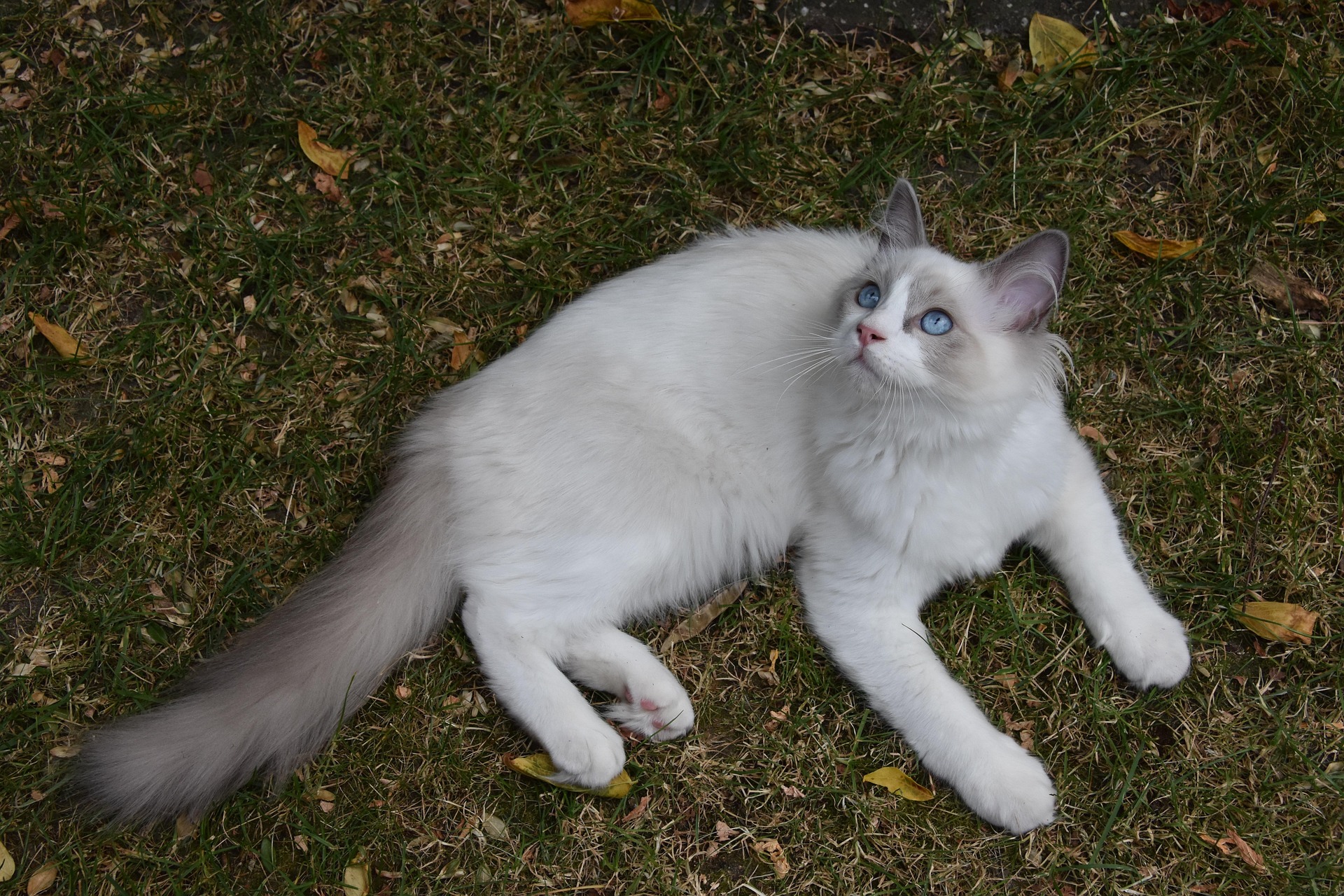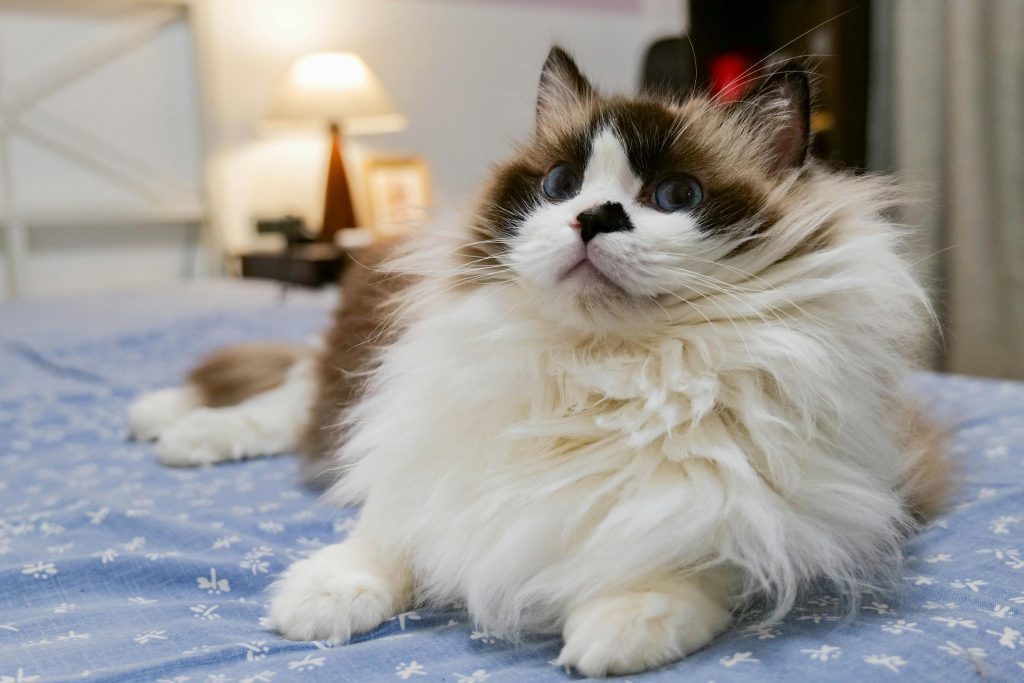If your Ragdoll waits by the cupboard at 6:58 or sits on the grooming mat before you even ask, you’re already seeing intelligence at work. Some cats win you over with flashy tricks, others with quiet genius—and Ragdolls often fall into the latter camp.
Ragdoll intelligence shows up in social savvy, calm problem-solving, adaptability, and trainability in everyday life.
In this guide, we’ll explore their smarts across three dimensions—Emotional/Social, Practical/Problem-Solving, and Trainability—while debunking the “calm means slow” myth and revealing how steady focus can be their hidden advantage.
What Does “Cat Intelligence” Really Mean?
Cat intelligence isn’t a single “IQ score” — it’s a blend of problem-solving, memory, social/emotional skills, and trainability that shows up in everyday life. A clever cat might wait by the cupboard minutes before feeding time, showing temporal memory (telling time by routine), or calmly navigate around a barrier instead of pawing at it (flexibility).
Scientists measure these abilities using puzzle boxes, delayed-reward tests, and social cue studies — but results often hinge on motivation, rather than raw brainpower. Many cats skip food puzzles if the reward is bland; swap in freeze-dried chicken and watch the “IQ” jump.
Ragdolls are bred for calm companionship. They often excel at social learning but may be less interested in food puzzles. Look for signs of learning and adaptability—not just tricks. Here’s how those smarts appear in everyday Ragdoll life—and how they differ from high-arousal breeds.
Unique Intelligence Traits of Ragdoll Cats
Ragdoll cats aren’t “just calm” — their intelligence shines in four distinct ways that make them a joy to live with and surprisingly trainable:
- Emotional intelligence – they read your mood and adjust their behavior (you’ll see this when they quietly settle beside you after a long day).
- Social smarts – they cooperate with people and pets, often learning routines faster when guided by your cues (like coming when you pat the sofa).
- Memory for routines – they anticipate events, such as waiting by the cupboard exactly two minutes before dinner.
- Willing participation – they happily join in fetch, harness walks, or mat training (you’ll notice this when they sit calmly before you clip the harness without being asked).
Build on these traits through relationship-focused interactions, pairing small treats with social praise or a feather flick—many Ragdolls work harder for “Good job + scritches” than kibble alone.
You Might Also Like
Ragdoll Cats vs. Other Breeds
Ragdolls excel at calm, cooperative tasks—they remember routines, follow social cues, and tolerate grooming or harness training with ease.
- Ragdoll – calm focus, strong routine memory, cooperative in grooming and harness work (at the doorbell, they’re more likely to sit and wait for guests).
- Bengal – novelty seekers that power through active puzzles and chase variety.
- Siamese – social-vocal experts, quick to follow pointing or spoken cues.
- Maine Coon – highly trainable and more tolerant of supervised outdoor time
Many Ragdolls may take longer to crack a complex feeder, but often outshine others in focus-driven training. Because they’re low-arousal, they may not push through high-stress, outdoor challenges—trade that risk for window perches, hunter-mode wand play, and rotating scent trails. Calm doesn’t mean slow—it means smart in a different way.
Can You Teach a Ragdoll to Be Smarter?
Absolutely — while you can’t turn your Ragdoll into a feline Einstein overnight, you can steadily boost their problem-solving, memory, and social learning through short, consistent, and humane enrichment.
Focus on micro-sessions (2–5 minutes) that mix a tiny treat with “good” and a 3-second cheek rub. Rotate puzzle feeders, introduce scent trails, and chain simple behaviors—nose-touch a target → follow it to a mat → “park” there for 5–10 seconds.
Progress comes from small wins, not instant genius—try calm greetings with a 10-day plan: Day 1–2 capture a natural sit; Day 3–4 add the cue “sit”; Day 5–7 add mild distractions (door knock sound); Day 8–10 practice a 10-second wait before greeting.
Two minutes count—end while they still want more. Keep it positive, predictable, and stress-free, and your Ragdoll will surprise you with how quickly they adapt, engage, and shine.
Debunking the “Dumb Ragdoll” Myth
Are Ragdolls smart? Absolutely — they just express intelligence differently. Selective breeding for calmness and sociability means their strengths show in quiet competence rather than flashy stunts: calm social problem-solving, strong memory for routines, and high trainability when motivated by social rewards.
Their low-arousal nature isn’t laziness—it’s an edge in tasks needing persistence and self-control. Think: waiting by the cupboard two minutes before breakfast, or calmly offering a paw at the vet when reinforced for stillness.
To see your cat’s smarts, run three simple tests—detour, object permanence, and follow-pointing—three times each on different days. Log time-to-solve and calm waiting. And if they walk away mid-test? That’s data too: the reward just wasn’t worth it.
You Might Also Like
Indoor Adaptation & Problem-Solving
Ragdolls are natural indoor pros—their calm, people-focused temperament translates into quick pattern learning, strong spatial memory, and low-stress problem-solving. Most will map out safe zones (favorite perch, quiet corner) within days, remember feeding times to the minute, and use your social cues as guidance.
Encourage this with rotating enrichment: (1) snuffle mat with 8–10 treat hides, (2) cardboard “detour” maze to reach a wand toy, (3) silvervine-scent trail leading to a perch. To teach a detour, place a low barrier between your cat and the toy, mark/treat the first sideways step, then increase the distance in three small jumps.
Their low-arousal steadiness means they won’t panic at new setups—use that to layer challenges gradually, even in a 5-minute Sunday night setup. Indoors, a Ragdoll’s “quiet” is attentive adaptability in action.
Final Thoughts
Across emotional/social intelligence, problem-solving, and trainability, Ragdolls shine in calm focus and routine memory. They’re socially tuned, reliably trainable, and built for household life. Their smarts show in emotional depth, strong routine recall, and an ability to stay composed under pressure—a huge asset for grooming, vet visits, and indoor adaptation.
Yes, they’re less driven by frantic puzzle-solving, but that makes them masters of steady learning and inhibitory control. Intelligence here isn’t an IQ score—it’s connection, adaptability, and trust.
Start tonight:
- 3× daily micro-sessions (2–5 min)
- Pair 1 tiny treat with praise or a cheek rub
- Rotate enrichment weekly (puzzle, scent trail, or perch change)
Pick one test (detour, object permanence, or social cue) and one short training game. Run them for 7 days, log results. If this helped, send it to a Ragdoll friend!

Hi, I’m Abir Ahamed—a writer, editor, and proud cat lover with a passion for feline welfare. I use my words to educate, inspire, and advocate for responsible pet care. Based in Bangladesh, I bring a unique perspective to Cats Question, hoping to help cat lovers make informed, compassionate choices.






